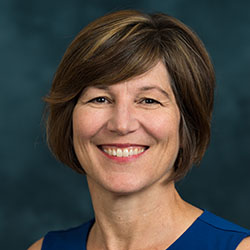New Targets and Repurposed Therapies for Sarcomas
Leveraging single-cell assays, 3D gel matrixes, and nanobodies to discover targets and expand therapeutic options for patients with Ewing and other sarcomas
Technology Overview
 Dr. Elizabeth Lawlor
Dr. Elizabeth Lawlor
Ewing sarcoma is a highly malignant cancer of bone and soft tissue. Although rare, it is still the second most common bone malignancy in children and adolescents. Disease contributors include oncogenic activity that hijacks normal stem cell programs, disrupts gene regulation through epigenetic mechanisms and induces cells to develop along a tumorigenic rather than normal developmental path. Current treatment primarily begins with multidrug chemotherapy.
Pediatric oncologist Elizabeth R. Lawlor, MD, PhD, makes discoveries about the fundamental biology of Ewing sarcoma that have the potential to advance therapies for multiple solid tumors. One focus is identifying existing drugs that can be repurposed to target pathways critical to Ewing sarcoma.
Dr. Lawlor and collaborators found that inhibition of menin, a key partner in menin-MLL epigenetic complexes, reduces Ewing sarcoma colonization and metastasis. The researchers are now using animal models to test the antimetastatic effects of small-molecule menin inhibitors including Kura’s ziftomenib, Janssen’s JNJ-75276617, Sumitomo’s enzomenib/DSP-5336, Biomea Fusion’s BMF-219, BioNova’s BN104 and Syndax’s revumenib/VTP50469, which is FDA approved for leukemias. The results could extend the uses and patient population for the drugs.
In parallel work, the Lawlor group is generating camelid-derived nanobodies against tenascin-C (TNC), which is abundant in many metastatic tumors. Nanobodies are antigen-binding domains of only variable heavy chains (VHH) that are much smaller than monoclonal antibodies. Potential applications for TNC-targeted therapeutics expand beyond Ewing sarcoma to numerous other cancers including breast, prostate and pancreatic cancers as well as glioblastomas, osteosarcomas and melanomas. TNC-specific nanobodies have potential as targeted, antimetastatic antibody-drug conjugates. The researchers are also generating novel nanobodies that bind mouse TNC, as a tool for testing preclinical efficacy and safety.
In collaboration with materials scientists at Seattle Children’s and the University of Washington, the Lawlor Lab invented a synthetic 3D biomatrix that mimics the environment that promotes Ewing sarcoma metastasis and relapse. The matrix has broad applications, including identifying new therapeutic targets for immunotherapy and screening existing and new small molecule drugs for sarcomas and carcinomas. The researchers are also exploring the wound-healing properties of the matrix.
To identify additional therapeutic targets, Dr. Lawlor and team also study dysregulation of developmental programs such as Wnt/beta-catenin and TGF-beta signaling pathways and HOXD transcription factors as drivers of Ewing sarcoma progression.
In addition to her Seattle Children’s Research Institute appointment, Dr. Lawlor is affiliated with the University of Washington and Fred Hutch Cancer Center. Along with Seattle Children’s Hospital, these institutions have a strong history of sarcoma research and clinical trials. Dr. Lawlor’s team has experience with in vitro studies including spatial biology profiling of tumor tissue microarrays from patient biopsies and resections. They also have expertise in drug testing using mouse xenograft models of sarcomas.
Dr. Lawlor has worked with biotech startup companies. She is interested in working with industry partners on using foundational biological findings to identify new applications for existing drugs to improve treatment for Ewing sarcoma and other cancers.
Stage of Development
- Preclinical in vitro
- Preclinical in vivo
Partnering Opportunities
- Collaborative research and development
- Sponsored research agreement
- Consultation agreement
- Tissue sample access
- Animal model access and expertise
Publications
Ganapathi SS, Wrenn ED, Garcia NM … Lawlor ER. Transcriptional rewiring of BET inhibitor treated Ewing sarcoma cells augments their dependency on focal adhesion kinase. bioRxiv. 2025;09.02.673849.
Wrenn ED, Harris JC, Apfelbaum AA … Lawlor ER. Autocrine TGFβ2 enforces a transcriptionally hybrid cell state in Ewing sarcoma. bioRxiv. 2025;12:2025.06.11.653876.
Wrenn ED, Apfelbaum AA, Rudzinski ER … Lawlor ER. Cancer-associated fibroblast-like tumor cells remodel the Ewing sarcoma tumor microenvironment. Clin Cancer Res. 2023;29(24):5140-5154.
Apfelbaum AA, Wu F, Hawkins AG … Lawlor ER. EWS::FLI1 and HOXD13 control tumor cell plasticity in Ewing sarcoma. Clin Cancer Res. 2022;28(20):4466-4478.
Jiménez JA, Apfelbaum AA, Hawkins AG … Lawlor ER. EWS-FLI1 and menin converge to regulate ATF4 activity in Ewing sarcoma. Mol Cancer Res. 2021; 19(7):1182-1195.
Hawkins AG, Pedersen EA, Treichel S … Lawlor ER. Wnt/β-catenin-activated Ewing sarcoma cells promote the angiogenic switch. JCI Insight. 2020;5(13):e135188.
Svoboda LK, Teh SSK, Sud S … Lawlor ER. Menin regulates the serine biosynthetic pathway in Ewing sarcoma. J Pathol. 2018;245(3):324-336.
Learn More
